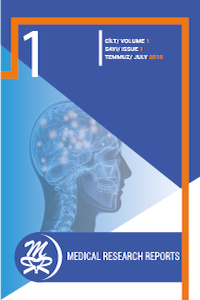AKSESUAR MEME TANISI ALAN HASTALARIMIZIN DEĞERLENDİRİLMESİ
Memenin sayı ve yerleşim bozuklukları süt kıvrımının gerilemesindeki sorunlar nedeniyle oluşmaktadır. Ektopik (aksesuar) meme dokusunda sadece meme başı varsa politeli; areola ve glanduler doku varsa polimasti olarak isimlendirilmektedir. Politeli çocuklarda memenin en sık görülen anomalisidir. Büyük çocuklarda nevüs veya deri katlantısı ile karışabilen küçük pigmente lezyon olarak da ortaya çıkabilmektedir. Sonuç olarak politeli hastalarda hiçbir klinik yakınmaya neden olmayan yapısal lezyondur. Politeli kozmetik açıdan önemli olması dışında böbrek anomalileri ile birlikte olma ihtimali sebebi ile idrar tahlili ve böbrek ultrasonu yapılması da akılda bulundurulmalıdır.
EVALUATION OF PATIENTS WITH ACCESSORY BREAST DIAGNOSIS
The disorders of number and localisation of the breast is caused due to the regression anomaly of milk line. The accessory breast only has nipple it is called polythelia, and if it has glandular tissue and areola it is called polymastia. Polythelia is the most common anomali of the breast among children. It can be misdiagnosed as nevus, small pigmented lesion or skin tag. Finally it is a lesion that does not cause any clinical problem and complaint. It may cause cosmetical problems and may be seen with renal problems infrequently, a rare problem which should be kept in mind.
Keywords:
child, breast, polythelia,
___
- Referans1. Aydoğan F, Gümüş M. Memenin Konjenital Anomalileri ve Gelişme Bozuklukları. Özmen V, Cantürk Z, Çelik V et al. ed. Meme Hastalıkları Kitabı, Güneş Tıp Kitapevi, 2012: 17-27.
- Referans2. Duflos C, Plu-Bureau G, Thibaud E, Kuttenn F. Breast diseases in adolescents. Endocr Dev. 2004;7:183-96.
- Referans3. Şıklar Z. Ergenlerde görülen meme hastalıkları. Türk Ped Arş 2011;46:85-7.
- Referans4. Greydanus DE, Matytsina L, Gains M. Breast disorders in children and adolescents. Prim Care 2006;33:455-502.
- Referans5. Fallat ME, Ignacio RC. Breast Disorders in Children and Adolescents. J Pediatr Adolesc Gynecol 2008;21:311-6.
- Referans6. Guray M, Sahin A. Benign Breast Diseases: Classification, Diagnosis and Management. The Oncologist 2006;11:435-49.
- Referans7. Pryor LS, Lehman JA Jr, Workman MC. Disorders of the female breast in the pediatric age group . Plast Reconstr Surg. 2009;124:50-60.
- Referans8. Brandt ML. Disorders of the Breast. In: Grosfeld JR, ed. Pediatric Surgery. PA, Mosby, 2006: 885-893.
- Referans9. Gilmore HT, Milroy M, Mello BJ. Supernumerary nipples and accessory breast tissue. S D J Med. 1996;49:149-151.
- Referans10. Garcia JJ, Verkauf BS, Hochberg CJ, Ingram JM. Aberrant breast tissue of the vulva. A case report and review of the literature. Obstet Gynecol. 1978;52:225-8.
- Referans11. Velanovich V. Ectopic breast tissue, supernumerary breasts, and supernumerary nipples. South Med J. 1995;88:903-6.
- Referans12. Latham K, Fernandez S, Iteld L, Panthaki Z, Armstrong MB, Thaller S. Pediatric breast deformity. J Craniofac Surg. 2006;17:454-67.
- Referans13. Aydoğan F, Baghaki S, Celik V, Kocael A, Gokcal F, Cetinkale O, et al. Surgical treatment of axillary accessory breasts. Am Surg. 2010;76:270-2.
- Referans14. Grossl NA. Supernumerary breast tissue: Historical perspectives and clinical features. South Med J. 2000;93:29-32.
- Referans15. Schmidt H. Supernumerary nipples: Prevelance, size, sex and side predilection. A prospective clinical study. Eur J Pediatr. 1998;157:821.
- Referans16. Pelligrini Jr, Wagner RF Jr. Polythelia and associated conditions. Am Fam Physician. 1983;28:129-132.
- Referans17. Bland Kl, Copeland EM III. The Breast: Comprehensive Management of Benign and Malignant Disorders. 3rd ed. Philadelphia: Elsevier; 2004:212-215.
- Referans18. Casey HD, Chasan PE, Chick LR. Familial polythelia without associated anomalies. Ann Plast Surg. 1996;36:101-104.
- Referans19. Sadove AM, Van Aalst JA. Congenital and acquired pediatric breast anomalies: a review of 20 years experience. Plast Reconstr Surg. 2005;115:1039-50.
- Yayın Aralığı: Yılda 3 Sayı
- Başlangıç: 2017
- Yayıncı: M. Tayyib KADAK
Sayıdaki Diğer Makaleler
EKOKARDİYOGRAFİ LABORATUARINDA TORASİK AORT ANEVRİZMASININ TESPİTİ VE İLİŞKİLİ DURUMLAR
Mustafa ELİAÇIK, Sevil KARAMAN ERDUR
AKSESUAR MEME TANISI ALAN HASTALARIMIZIN DEĞERLENDİRİLMESİ
Meltem UĞRAŞ, Öznur KÜÇÜK, Gülay ÇİLER ERDAĞ, Defne ÇÖL, Tuba GİRAY, Ayça VİTRİNEL
GELİŞİMSEL KALÇA DİSPLAZİSİ TARAMASINDA ULTRASONOGRAFİNİN YERİ
Abdüsselam BATU, Cem Cahit BARIŞIK, Mustafa ÇİFTÇİ, Fırat ERDOĞAN
ACİL SERVİSTEN KALP VE DAMAR CERRAHİSİ BÖLÜMÜNE YATIRILAN HASTALARIN ÖZELLİKLERİ
Sema AVCI, Bulut DEMİREL, Zarife SELVAN
ISOLATED SPLEEN CYST HYDATID SPLEEN PRESERVATIVE SURGICAL TREATMENT
